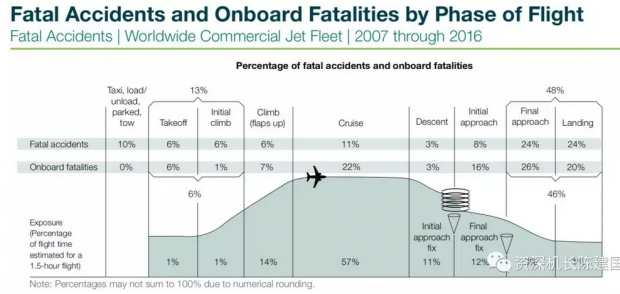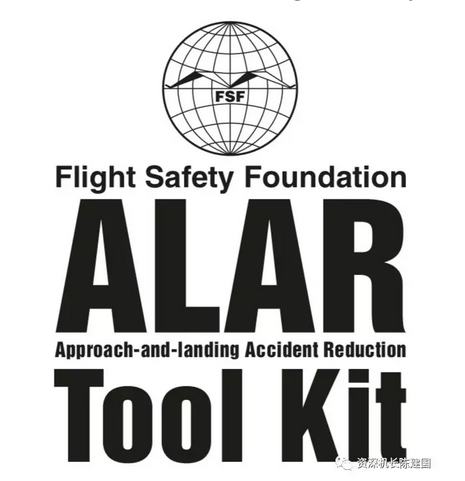根据波音发布的全球范围内商业喷气客机事故报告(Statistical Summary of Commercial Jet Airplane Accidents Worldwide Operations),商业飞行事故中超过一半是在进近和着陆阶段发生的,而稳定进近是安全着陆的最基本条件之一,有一定的因果关系。
稳定进近概念的提出
目前大部分的航空公司强调稳定进近的概念,其中有公司对其中的来源和定义有所混淆,造成对定义的误解误读,这里做一个简单的介绍:
最早的稳定进近要素的提出来源于FSF,即Flight Safety Foundation。
其中一个工作组ALAR是做“降低进近与着陆事故工作组”的,他们做了大量的研究发现,从1984年到1997年,66%的进近着陆事故和严重事故征候和不稳定进近有关。于是该该工作组做了一个推荐的稳定进近的标准:
Table 1 Recommended Elements Of a Stabilized Approach
All flights must be stabilized by 1,000 feet above airport elevation in instrument meteorological conditions (IMC) and by 500 feet above airport elevation in visual meteorological conditions (VMC). An approach is stabilized when all of the following criteria are met:
The aircraft is on the correct flight path;
Only small changes in heading/pitch are required to maintain the correct flight path;
The aircraft speed is not more than VREF + 20 knots indicated airspeed and not less than VREF;
The aircraft is in the correct landing configuration;
Sink rate is no greater than 1,000 feet per minute; if an approach requires a sink rate greater than 1,000 feet per minute, a special briefing should be conducted;
Power setting is appropriate for the aircraft configuration and is not below the minimum power for approach as defined by the aircraft operating manual;
All briefings and checklists have been conducted;
Specific types of approaches are stabilized if they also fulfill the following: instrument landing system (ILS) approaches must be flown within one dot of the glideslope and localizer; a Category II or Category III ILS approach must be flown within the expanded localizer band; during a circling approach, wings should be level on final when the aircraft reaches 300 feet above airport elevation; and,
Unique approach procedures or abnormal conditions requiring a deviation from the above elements of a stabilized approach require a special briefing.
An approach that becomes unstabilized below 1,000 feet above airport elevation in IMC or below 500 feet above airport elevation in VMC requires an immediate go-around.
Source: Flight Safety Foundation Approach-and-landing Accident Reduction (ALAR) Task Force (V1.1 November 2000)
翻译过来基本上是这样:
飞机处于正确的飞行航径
为保持正确的飞行航径只需要稍微改变俯仰和航向
飞机的进近速度不大于Vref+20,不小于Vref(编者注:各机型要求不同)
飞机处于正确的着陆形态
下降率不大于1,000英尺/分钟;如进近要求下降率大于1,000英尺/分钟,应事先执行特殊的简令
推力调定与飞机的形态相适应,并不低于机型操作手册规定的最低进近推力
所有简令和检查单已执行
特定类型的进近还需满足下列要求才为稳定进近:
一类ILS进近应在下滑道和航向道的1个点之内飞行, 二类和三类ILS在扩展的航向道刻度内飞行
在盘旋进近中,当飞机达到高于机场标高300英尺时飞机应当处于五边上,且机翼应水平。
如特定的进近程序或非正常条件要求偏离上述稳定进近标准,飞行组应执行特殊简令。
注:在仪表气象条件下高于机场标高1,000英尺以下或目视气象条件下高于机场标高500英尺以下如进近过程不稳定,应立即复飞。
容易混淆的概念
1000英尺和500英尺,是针对于IMC和VMC的,即仪表气象条件和目视气象条件,并不是仪表飞行规则和目视飞行规则。
很多公司在自己的SOP或者相关手册中将这两个概念混淆起来,这个推荐稳定进近的标准1000英尺和500英尺本身是对于气象条件的要求,并不是进近方式的要求。
进近时的VMC条件要求能见度大于5km、距云的距离垂直距离不小于300米,水平距离不小于1.5km。(CCAR91.155)
随意提高推荐标准
因为稳定进近很重要,有些公司为了不触及稳定进近的“红线”,随意的提高自己的稳定进近的标准,有的1200英尺、有个1500英尺,其实这些都是没有意义的,应该没有正确理解稳定进近的意义和如何具体实现。
正确的做法应该是什么样呢?
怎么构建稳定进近
ALAR工作组提出了自己的四项策略性建议:
Anticipate 预判
Detect 感知
Correct 修正
Decide 决策
(待续)




 京公网安备 11010502034662号 | 广播电视节目制作经营许可证:京第01015号 | 出版物经营许可证:第直100013号
京公网安备 11010502034662号 | 广播电视节目制作经营许可证:京第01015号 | 出版物经营许可证:第直100013号